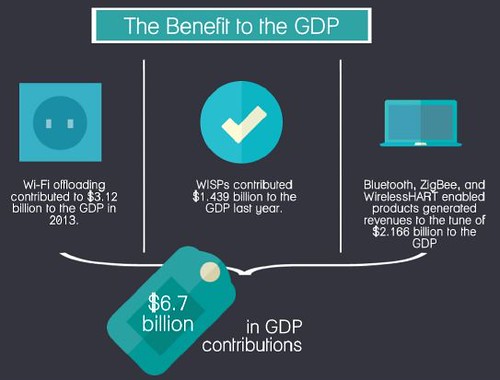At last week’s FCC meeting, the commission made a commitment to set aside 1-3 channels of broadcast spectrum for unlicensed use at next year’s incentive auction. Earlier this year the FCC made 100 megahertz of 5GHz spectrum available for Wi-Fi.
In remarks at an event sponsored by WifiForward (Twitter), an industry group whose members include Google and Comcast, Democratic FCC Commissioner Jessica Rosenworcel voiced strong support for what she described as an “unlicensed spectrum game plan.”
“It should no longer be an afterthought in our spectrum policy,” she said.
Up to 120 megahertz (MHz) of coveted, 600 MHz low-band spectrum, could be voluntarily given up by television broadcasters in exchange for a portion of the proceeds of an auction. It would repurpose TV Channels 30-51 for cellular communications.
The FCC and others have predicted that somewhere between 100-70 Mhz may be available. If broadcasters made 90 MHz of spectrum available, that would leave space for only four carriers (80 MHz), plus one 10 MHz TDD channel (perhaps unlicensed at low power). Carriers are expected to bid on paired (10?0 MHz) (20 MHz total) blocks or perhaps 20?0 (40 MHz) blocks.
Last week the FCC announced a “restricted” license plan that reserved 30 MHz for smaller carriers. That would prevent AT&T and Verizon from bidding on the 30 MHz of reserved spectrum if they hold more than 45 MHz of spectrum below 1 GHz in that market.
Doing the math, if 90 MHz is available in a market, and 30 MHz is reserved for small carriers, that leaves 60 Mhz available for Verizon and AT&T. Only one 20 x 20 Mhz channel (40 Mhz total) would then be available (let’s say for AT&T). That leaves one 10 x 10 channel (let’s say Verizon).
The 30 Mhz of restricted spectrum will have room for only one 10?0 (20 MHz total). That leaves room only for one 5? (10Mhz total) channel.
It hardly seems cost/effective for a small carriers who have very little sub 1 GHz infrastructure in place. Am I missing something here?
I know it’s late in the game, but why not make 20 MHz available (free) as unlicensed frequencies? First responders could use that spectrum, too.
All carriers could then bid on the remaining 40-80 MHz, but no single carrier could own more than 25% of the remaining spectrum.
Nationwide, unlicensed WiFi is getting taken over by Comcast, AT&T, Facebook and others. They will charge for access (if you’re not a subscriber).
But “free” WiFi, like “free” radio and television, should be a right.
A WifiForward study found that unlicensed spectrum generated $222 billion in overall value to the U.S. economy in 2013 and contributed $6.7 billion to U.S. GDP.
Today Wi-Fi is in more than 60 percent of U.S. homes and businesses. How many cups of coffee each day might go unsold if there was not “free Wi-Fi” in coffee shops?
Unlicensed frequencies are a major driver of the economy. It seems fiscally irresponsible to minimize the value of unlicensed frequencies on the 600 MHz band.
The Wireless Broadband Alliance predicts that the number of public Wi-Fi hotspots globally will grow more than fourfold, to 5.8 million, by 2015.
The Global Wi-Fi Market will be worth $93.23 Billion by 2018, according to MarketsandMarkets. Machine to Machine (M2M), Carrier Wi-Fi, Outdoor Wi-Fi, Wi-Fi on the Go and In-Flight Wi-Fi are some of the most lucrative markets for Wi-Fi.
Machine-to-machine communications alone is posed to create whole new industries — but not if carriers control pricing.
Posted on Tue, 20 May 2014 17:15:15 +0000 at http://www.dailywireless.org/2014/05/20/...-carriers/
Comments: http://www.dailywireless.org/2014/05/20/.../#comments



